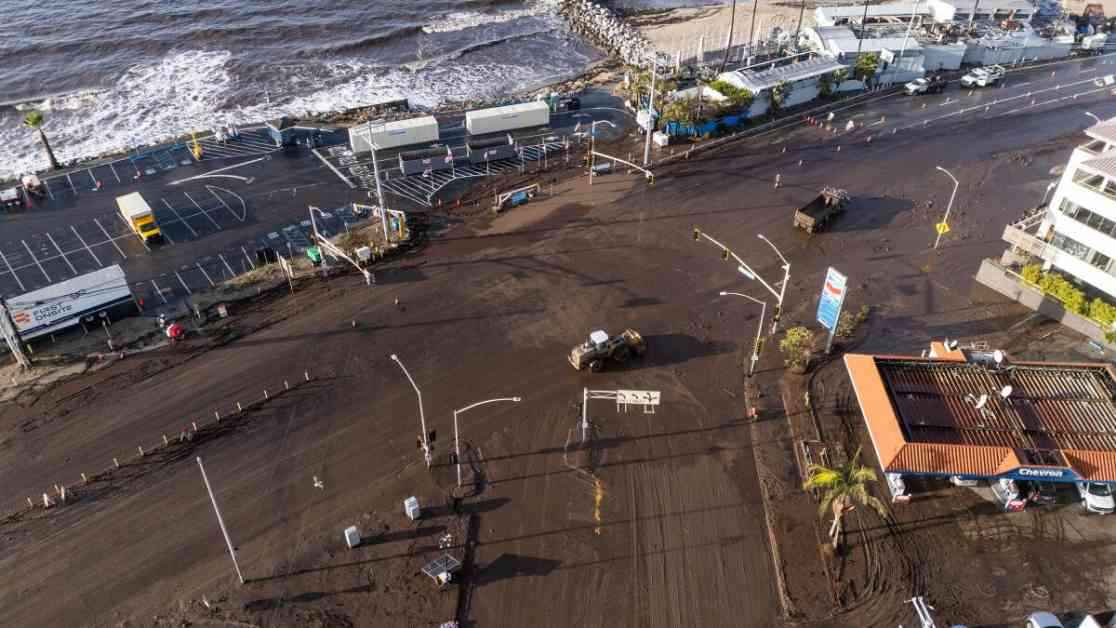California’s Wild Weather Ride: From Drought to Deluge on Pacific Coast Highway
Just a few weeks ago, the Pacific Coast Highway in California was a scene of destruction, ravaged by one of the most devastating firestorms in Los Angeles County history. The charred remains of oceanside homes served as grim reminders of the ferocity of the flames that tore through the landscape.
However, the narrative quickly shifted as a powerful rainstorm hit the region, turning the scorched hillsides into a river of mud and debris. The picturesque coastal road transformed into a muddy battleground, with cascading rocks and sediment reshaping the canyons in their wake.
This dramatic shift from drought to deluge is not unfamiliar to the residents of Southern California, who have long endured the cyclical pattern of fires followed by floods and debris flows. Yet, the recent events have brought a unique and intense climate whiplash to areas like the Pacific Palisades and Altadena burn zones, testing the resilience of the communities in the face of nature’s fury.
The Fires and the Drought
The fires that engulfed the region were fueled by a prolonged lack of winter rain, leaving the landscape unusually parched and vulnerable to ignition. The bone-dry conditions in January set the stage for the catastrophic firestorms that consumed neighborhoods in Pacific Palisades, Malibu, and Altadena, leaving behind a trail of devastation.
Captain Erik Scott of the Los Angeles Fire Department aptly described the situation as a “one-two punch,” highlighting the rapid succession of hazardous events that unfolded within a short span of time. The urgency to remove hazardous materials, clear fire debris, and address the looming threat of rain and mudslides added layers of complexity to an already dire situation.
The Storm and its Aftermath
As the storm hit the region with unprecedented force, mudslides and rockslides became a common sight, with debris flows blocking roads and posing risks to residents. In Altadena, mudslides cascaded down streets, sending people fleeing for safety, while vehicles along Highway 330 in the San Bernardino Mountains were buried under layers of mud.
In Malibu, a fire department SUV was swept into the Pacific Ocean by a torrent of mud and tree branches, a symbolic representation of the chaos and destruction wrought by nature’s unrelenting forces. The once-charred homes and vehicles along the scenic coastal stretch now lay buried under a thick layer of sludge, a haunting reminder of the region’s vulnerability to extreme weather events.
The Climate Conundrum
The erratic weather patterns in California, characterized by rapid shifts between wet and dry conditions, have become increasingly common in recent years. Climate scientists warn of a new phase of climate change marked by more frequent and intense extreme events, such as the firestorms and mudslides that have become synonymous with life in Southern California.
Professor Steven Allison of UC Irvine sheds light on the unusual sequence of events that unfolded, from a prolonged drought leading to devastating wildfires to a sudden deluge exacerbating the damage. The concept of “hydroclimate whiplash” underscores the unpredictable nature of climate patterns and the challenges they pose to communities and ecosystems alike.
The Record-Breaking Storm
The recent storm that battered Southern California shattered decades-old rainfall records, leaving a trail of destruction in its wake. The deluge of rain, a stark departure from the region’s bone-dry conditions, inundated burn scars with fast-flowing mud and debris, posing significant risks to residents and infrastructure.
In the aftermath of the storm, road closures, power outages, and downed trees became common occurrences, underscoring the widespread impact of the extreme weather event. The amount of rain received, although significant, offers a temporary respite from the looming fire risk, providing a brief reprieve for a region grappling with the aftermath of back-to-back disasters.
The Road to Recovery
As crews work tirelessly to clear roadways and assess the damage caused by the storm, residents are left grappling with the uncertainty of what lies ahead. Jennifer Gaulke, a resident of Pacific Palisades, recounts her experience of navigating the aftermath of the fires and the subsequent rains, expressing gratitude for the minimal damage to her property amidst the chaos.
As California braces for the next chapter in its tumultuous weather saga, the resilience and resolve of its communities shine through, echoing a sentiment of hope and perseverance in the face of nature’s relentless onslaught.
The journey from drought to deluge on the Pacific Coast Highway serves as a stark reminder of the fragile balance between man and nature, urging us to reflect on our role in shaping a sustainable future for generations to come.


